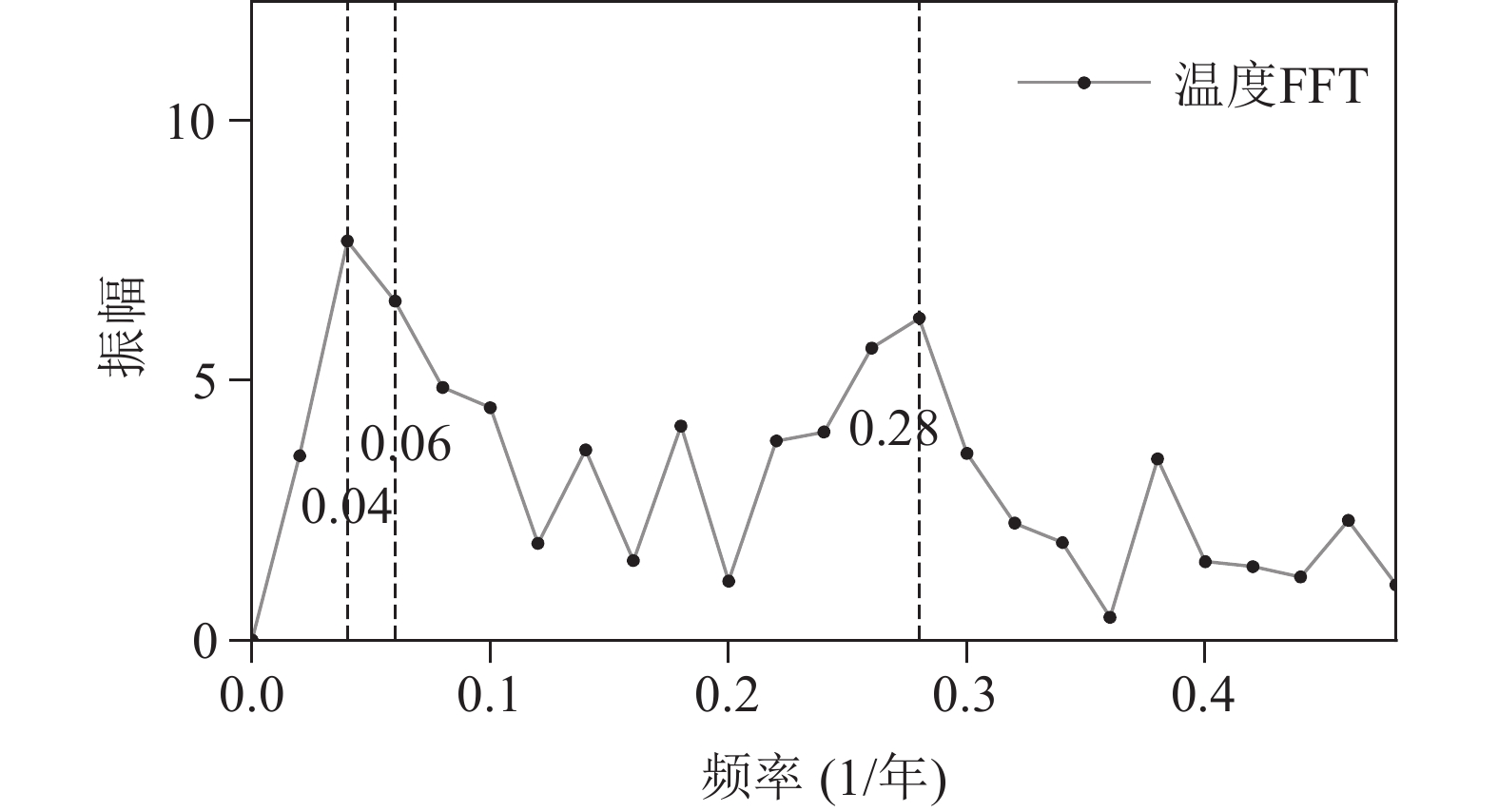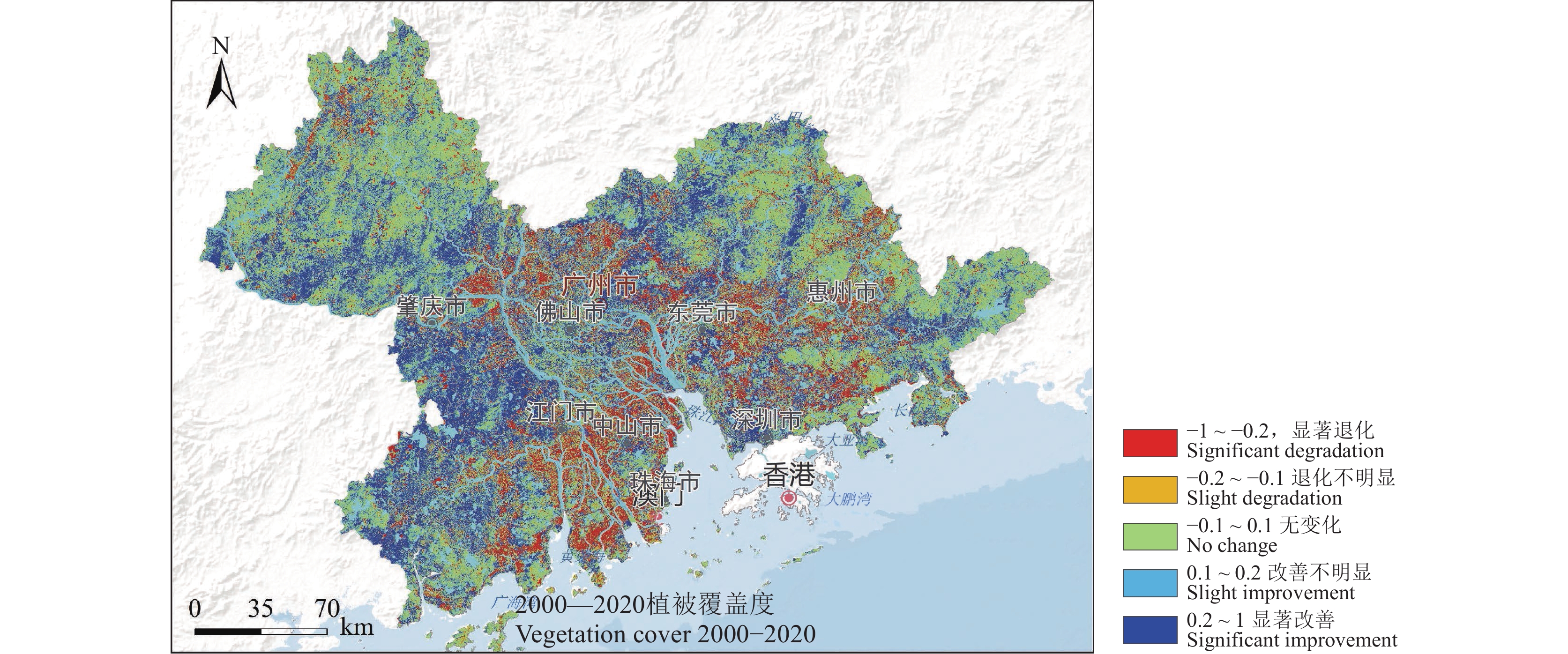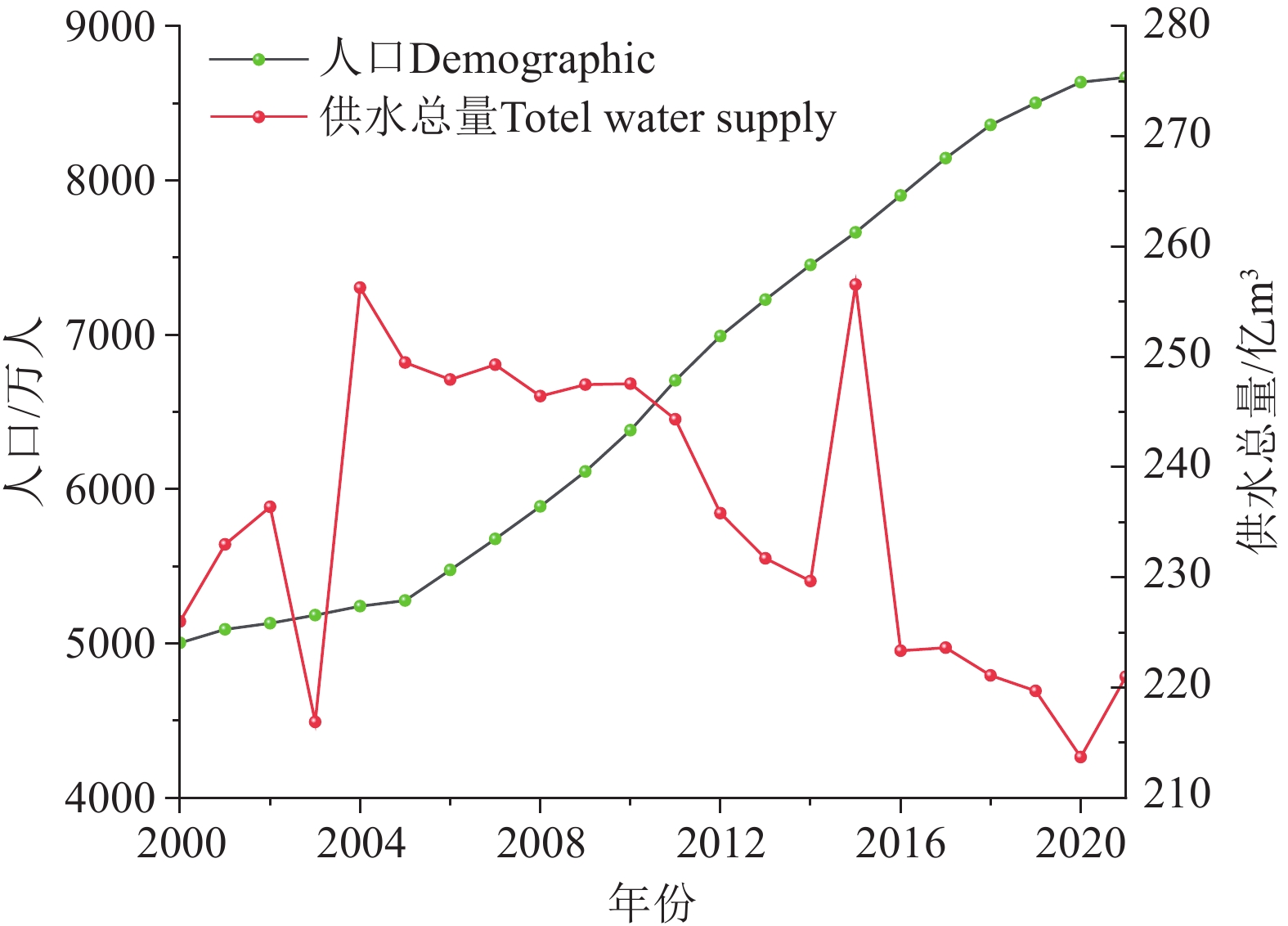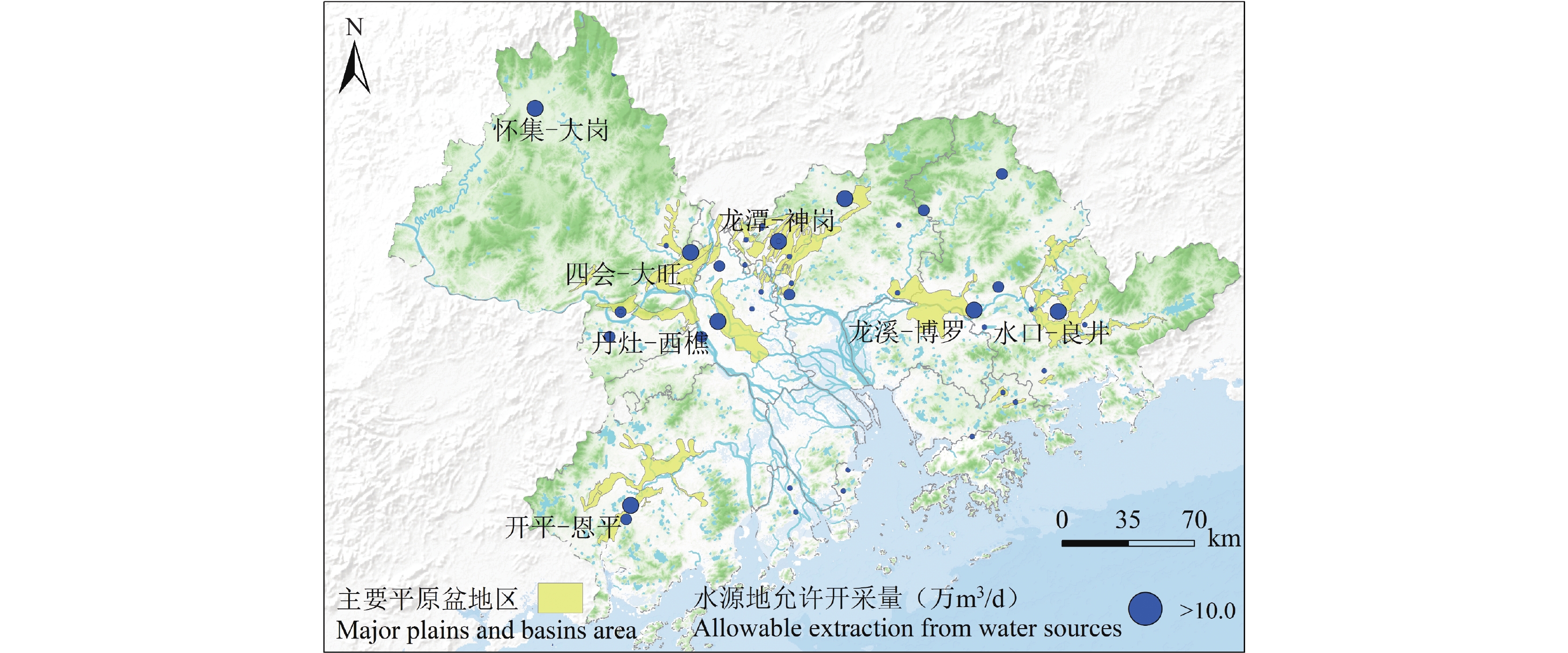Evolution of water resources and changes of ecological environment pattern in Guangdong−Hong Kong−Macao Greater Bay Area in the past 40 years
-
摘要:
研究目的 受气候变化与人类活动的双重影响,亟需深化对粤港澳大湾区水资源演变规律的认识,以期为实现区域水资源的可持续管理提供科学依据和决策支持。
研究方法 本文采用定性与定量相结合、历史文献资料的深度挖掘以及多源水资源监测数据,全面分析大湾区自1980年以来近40年间的水文、降水、地表覆盖等水资源环境格局变化及其区域分异规律。
研究结果 大湾区水资源状况总体上呈现"西多东少、北多南少"的分布特征,1980—2022年平均气温22.2℃,降雨2022.1 mm, 主要变化周期约4.1 a。西江、北江、东江干流平均径流量分别为11231.09 m3/s、1479.63 m3/s、809.42 m3/s,径流变差系数介于0.19~0.27,气候格局呈现出暖湿化的趋势,水体总量出现减少趋势,植被覆盖整体上升但局部出现退化,显著退化面积6225.98 km2,改善面积9537.31 km2;水体(含湿地)面积变化速率呈现“缓慢萎缩−加速萎缩−稳步增长−缓慢增长”的阶段性特征。
结论 提出具有开发远景的41处应急备用水源地,允许开采量达234.26万m3/d。大湾区具有水资源与经济发展的不协调、水生态服务功能退化、水资源时空分布不均及以地表水为主的供水水源结构单一等特点。
Abstract:This paper is the result of hydrogeological survey engineering.
Objective Due to the dual impacts of climate change and human activities, there is an urgent need to deepen the understanding of the evolution of water resources in the Greater Bay Area of Guangdong, Hong Kong and Macao, with a view to providing a scientific basis and decision−making support for the realization of the sustainable management of regional water resources.
Methods This paper employs a combination of qualitative and quantitative methods, leveraging in−depth analysis of historical literature alongside multi−source water resource monitoring data to comprehensively examine changes in hydrology, precipitation, land cover, and other environmental factors related to water resources in the Greater Bay Area over the past 40 years (1980–2020). It also explores the regional patterns of differentiation in these changes.
Results Our findings reveal a general water resource distribution trend of "abundance in the west and north, scarcity in the east and south," with an average temperature of 22.2℃ and annual precipitation of 2022.1 mm from 1980 to 2022. The study observes a major cyclical change every 4.1 years. The average runoff of the Xijiang, Beijiang, and Dongjiang Rivers is quantified, alongside the variation in runoff coefficients, reflecting a warm and humid climatic trend. Concurrently, the total volume of water bodies exhibits a declining trajectory, while vegetation cover overall shows an increase but with local degradation.
Conclusions The study identifies 41 potential emergency backup water sources, with a sustainable extraction capacity of 2342600 m3/day.It highlights the ongoing mismatch between water resources and economic development in the Greater Bay Area, the reduction of water ecosystem service functions, the spatial and temporal imbalances in water resource distribution, and the region's over−reliance on a predominantly surface water−based supply structure.
-

-
表 1 大湾区水体面积变化特征
Table 1. Characteristics of water body area changes in Guangdong−Hong Kong−Macao Greater Bay Area
时间 阶段性特征 变化量/km2 变化率/(km2/a) 1980—1990 缓慢萎缩 −218 −21.8 1990—2000 加速萎缩 −463 −46.3 2000—2010 稳步增长 218 21.8 2010—2020 缓慢增长 119 11.9 合计 −344 −8.6 表 2 主要水源地靶区允许开采量
Table 2. Allowable extraction in the target area of the main water source
所属地级市 水源地名称 面积/
km2允许开采量/
(104m3/d)地下水类型 江门市 开平—恩平 412.50 26.66 孔隙潜水−承压水 惠州市 水口—良井 278.00 15.05 孔隙水 肇庆市 怀集—大岗 237.30 15.03 覆盖型岩溶水 广州市 花都—新华 169.65 13.29 覆盖型岩溶水 肇庆市 四会—大旺 369.40 12.29 孔隙潜水 惠州市 龙溪—博罗 364.80 12.28 孔隙潜水−承压水 广州市 龙潭—神岗 235.30 11.50 孔隙潜水 佛山市 丹灶—西樵 312.40 10.32 孔隙潜水 -
[1] Cao Jianwen, Xia Riyuan, Tang Zhonghua, Zhao Liangjie, Wang Zhe, Luan Song, Wang Song. 2021. Groundwater resources in Guangdong−Hong Kong−Macao Greater Bay Area and its development potential[J]. Geology in China, 48(4): 1075−1093 (in Chinese with English abstract).
[2] Cheng L, Song S, Xie Y. 2022. Evaluation of water resources utilization efficiency in Guangdong Province based on the DEA–Malmquist Model[J]. Frontiers in Environmental Science, 10: 17.
[3] Feng Xianhui, Zeng Zhilin, Zhang Deshun. 2022. Temporal–spatial evolution of vegetation coverage in Guangdong–Hong Kong–Macao Greater Bay Area based on MODIS NDVI Data[J]. Journal of Chinese Urban Forestry, 20(1): 1−6 (in Chinese with English abstract).
[4] Fu Xiang, Liu Hao. 2023. Spatial–temporal variation of vegetation NDVI and its response to climate in Guangdong–Hong Kong–Macao Greater Bay Area from 2012 to 2021[J]. Pearl River, 44(5): 73−80 (in Chinese with English abstract).
[5] Huang Y, Cai Y, Xie Y. 2022. An optimization model for water resources allocation in Dongjiang River Basin of Guangdong–Hong Kong–Macao Greater Bay Area under multiple complexities[J]. Science of the Total Environment, 820: 153198. doi: 10.1016/j.scitotenv.2022.153198
[6] Huang Yangman, Chen Xiaohong. 2023. The evolution of water ecological state and driving mechanism in Guangdong–Hong Kong–Macao Greater Bay Area[J]. Acta Scientiarum Naturalium Universitatis Sunyatseni, 62(2): 93−103 (in Chinese with English abstract).
[7] Jiang H, Peng J, Dong J. 2021. Linking ecological background and demand to identify ecological security patterns across the Guangdong–Hong Kong–Macao Greater Bay Area in China[J]. Landscape Ecology, 36: 2135−2150. doi: 10.1007/s10980-021-01234-6
[8] Ke Zongxian, Wang Donghai, Zeng Zhilin, Zhang Chunyan, Liang Zhaoming, Zhang Yu. 2023. Underlying surface effect on the extreme heavy rainfall event on 22 May 2020 in the Guangdong–Hong Kong–Macao Greater Bay Area[J]. Meteorological Monthly, 49(1): 12−26 (in Chinese with English abstract).
[9] Li Baihe, Gong Jianzhou. 2021. The variation of temperature in Guangdong–Hong Kong–Macao Greater Bay Area in recent 60 years[J]. Journal of Guangzhou University (Natural Science Edition), 20(1): 78−86 (in Chinese with English abstract).
[10] Li L, Chan P W, Deng T. 2021. Review of advances in urban climate study in the Guangdong–Hong Kong–Macau greater bay area, China[J]. Atmospheric Research, 261: 105759. doi: 10.1016/j.atmosres.2021.105759
[11] Li Jie, Li Yuanyuan, Ji Hongxiang. 2021. Study on countermeasures for water supply security in Guangdong, Hong Kong and Macao Greater Bay Area[J]. Pearl Rive, (102): 1−5 (in Chinese with English abstract).
[12] Li Jingxian, Wang Jun, Du Yihang, Cai Ailing. 2019. Change characteristics of coastal wetlands in the Pearl River Delta under rapid urbanization[J]. Wetland Science, 17(3): 267−276 (in Chinese with English abstract).
[13] Li Juan, Li Xingpin, Li Jie. 2022. Status quo of and countermeasures for water rescources management in Guangdong–Hong Kong–Macao Greater Bay Area[J]. Water Resources Development Research, 22(10): 65−70 (in Chinese with English abstract).
[14] Li Ningning, Qiu Jing, Chen Xiaohong, Li Zejun, Chen Yingyi. 2023. Analysis of temporal and spatial variation characteristics of rainfall in Dongjiang River Basin within Guangdong Province[J]. Journal of China Hydrology, 43(4): 74−80 (in Chinese with English abstract).
[15] Li Q, Wu J, Su Y. 2022. Estimating ecological sustainability in the Guangdong–Hong Kong–Macao Greater Bay Area, China: retrospective analysis and prospective trajectories[J]. Journal of Environmental Management, 303: 114167. doi: 10.1016/j.jenvman.2021.114167
[16] Lin Hui, Zhang Hongsheng, Lin Yinyi, Wei Shan, Wu Zhifeng. 2018. Spatiotemporal changes of gridded urban population in the Guangdong–Hong Kong–Macao Greater Bay Area based on impervious surface–population correlation[J]. Progress in Geography, 37(12): 1644−1652 (in Chinese with English abstract). doi: 10.18306/dlkxjz.2018.12.006
[17] Liu Chang, Lin Shenhui, Jiao Xueyao, Shen Xiaoxue, Li Ruili. 2019. Problems and treatment countermeasures of water environment in Guangdong–Hong Kong–Macao Greater Bay Area[J]. Acta Scientiarum Naturalium Universitatis Pekinensis, 55(6): 1085−1096 (in Chinese with English abstract).
[18] Liu Youping. 2020. Tendency of fluvial process and hydrologic extreme events in river network of Pearl Delta under Changing environment[J]. Journal of China Hydrology, 40(3): 71−75 (in Chinese with English abstract).
[19] Mao Zhihui, Li Lili, Du Jianjun. 2021. Research on temporal and spatial evolution of extreme temperature in Guangdong Province during past 60 years[J]. Journal of Zhongkai University of Agriculture and Engineering, 34(4): 30−39 (in Chinese with English abstract).
[20] Meng Ruifang, Yang Huifeng, Bao Xilin, Xu Buyun, Li Lei, Li Jjinzheng. 2024. Prospect analysis of unconventional water resources utilization and eco−environmental effects in Beijing−Tianjin−Hebei Plain[J]. Geology in China, 51(1): 221−233 (in Chinese with English abstract).
[21] Song Song, Wu Zhifeng, Cao Zheng, Sun Fangdi, Yang Jinxin, Zhang Qifei. 2023. The changing trend and driving factors of water frequency fluctuations in the Guangdong–Hong Kong–Macao Greater Bay Area[J]. Tropical Geography, 43(3): 372−383 (in Chinese with English abstract).
[22] Sun Zhangtao, Yu Zhengwei, Shu Siqi, Xu Chuangsheng, Shu Yang. 2023. Evaluation of ecosystem services of Chinese provincial land and suggestions for ecological geological survey[J]. Geology in China, 50(2): 479−494 (in Chinese with English abstract).
[23] Tan Qifeng, Cui Fuyi, Zhi Shiping, Zheng Hanggui. 2020. Researh Report on Water Resources in Guangdong, Hong Kong and Macao Greater Bay Area [M]. Beijing: Social Science Literature Publishing House (in Chinese with English abstract).
[24] Wang Y, Han Z, Gao R. 2021. Changes of extreme high temperature and heavy precipitation in the Guangdong–Hong Kong–Macao Greater Bay Area[J]. Geomatics, Natural Hazards and Risk, 12(1): 1101–1126.
[25] Wang Y, Huang C, Wu G. 2022. Status and challenges of water resources and supply in the Guangdong–Hong Kong–Macao Greater Bay Area (GBA) of China[J]. Water Cycle, 3: 65−70. doi: 10.1016/j.watcyc.2022.05.001
[26] Wu Pan, Zhao Xinwen, Gu Tao, Jiang Tuo, Wang Xusheng, Feng Yuqing. 2021. Water resources in the Guangdong–Hong Kong–Macao Greater Bay Area and its co–evolution trend with social economy: A comparative study with the international bay area[J]. Geology in China, 48(5): 1357−1367 (in Chinese with English abstract).
[27] Wu Yufan, Wang Jiangbo, Gou Aiping. 2023. The temporal and spatial evolution characteristics and driving factors of surface water in the Guangdong–Hong Kong–Macao Greater Bay Area since 1985[J]. Tropical Geography, 43(3): 395−407 (in Chinese with English abstract).
[28] Xia Riyuan, Lu Haiping, Cao Jianwen, Zhao Liangjie, Wang Zhe, Luan Song. 2022. Characteristics of groundwater resources of karst areas in the Southern China and water resources guarantee countermeasures[J]. Geology in China, 49(4): 1139−1153 (in Chinese with English abstract).
[29] Yang Chenchen, Gan Huayang, Wan Rongsheng, Zhang Yaoming. 2021. Spatiotemporal evolution and influencing factors of coastline in the Guangdong–Hong Kong–Macao Greater Bay Area from 1975 to 2018[J]. Geology in China, 48(3): 697−707 (in Chinese with English abstract
[30] Yang J, Huang X. 2021. The 30 m annual land cover dataset and its dynamics in China from 1990 to 2019[J]. Earth System Science Data, 13(8): 3907−3925. doi: 10.5194/essd-13-3907-2021
[31] Yang Yang, Zhao Liangjie, Xia Ri Yuan. 2022. Distribution and influencing factors of karst underground rivers in the Pearl River Basin[J]. Carsologica Sinica, 41(4): 562−576 (in Chinese with English abstract).
[32] Yang Yuandong, Wang Yonghong, Cai Silong, Liu Feng. 2019. Interannual and intra–annual variation characteristics of runoff in downstream areas of Pearl River Basin during 1960–2017[J]. Bulletin of Soil and Water Conservation, 39(5): 23−31 (in Chinese with English abstract).
[33] Yin Nannan, Tang Jun, Yang Yuanwei, Gao Xianjun, Song Shuhua, Hu Qian. 2023. Variations of shoreline and land use in Guangdong–Hong Kong–Macao Greater Bay Area from 1989 to 2021[J]. Marine Geology Frontiers, 39(5): 1−11 (in Chinese with English abstract
[34] You X, Li Q, Monahan K M. 2022. Can collaborative innovation constrain ecological footprint? Empirical evidence from Guangdong–Hong Kong–Macao Greater Bay Area, China[J]. Environmental Science and Pollution Research, 29(36): 54476−54491. doi: 10.1007/s11356-022-19648-3
[35] Yu Bowei, Xie Yiliang, Ma Xiyao, Cui Baoshan. 2022. Wetland landscape pattern change and its damage degree in Guanddong–Hong Kong–Macau Bay Area in recent 40 years[J]. Environmental Ecology, 4(5): 59−68 (in Chinese with English abstract) .
[36] Zhang Ling Jiang Zhijian, Huang Xiaoping. 2022. The protecting strategies about the atmosphere, water and wetland in Guangdong–Hong Kong–Macau Greater Bay Area[J]. Environmental Science and Management, 47(11): 160−165 (in Chinese with English abstract).
[37] Zhang Zhilin, Qiu Jing, Cheng Tao, Huang Bensheng, Feng Ziying. 2022. Urban flood issues and analysis in the Guangdong–Hong Kong–Macao Greater Bay Area[J]. Journal of Hydraulic Engineering, 53(7): 823−832 (in Chinese with English abstract).
[38] Zhao Liangjie, Yang Yang, Cao Jianwen, Xia Riyuan, Wang Zhe, Luan Song, Lin Yushan. 2021. Groundwater resources evaluation and problem analysis in Pearl River Basin[J]. Geology in China, 48(4): 1020−1031 (in Chinese with English abstract).
[39] Zhao Lingling, Xia Jun, Yang Fang, Yang Long, Xu Fei. 2021. Current situation, framework, problems and prospect of water ecological restoration in Guangdong–Hong Kong–Macao Greater Bay Area[J]. Acta Ecologica Sinica, 41(12): 5054−5065 (in Chinese with English abstract).
[40] Zhou Y, Luo Z, Li S. 2022. Temporal and spatial variations of extreme precipitation in the Guangdong–Hong Kong–Macao Greater Bay area from 1961 to 2018[J]. Journal of Water and Climate Change, 13(1): 304−314. doi: 10.2166/wcc.2021.078
[41] 曹建文, 夏日元, 唐仲华, 赵良杰, 王喆, 栾崧, 王松. 2021. 粤港澳大湾区地下水资源特征及开发潜力[J]. 中国地质, 48(4): 1075−1093. doi: 10.12029/gc20210407
[42] 冯娴慧, 曾芝琳, 张德顺. 2022. 基于 MODIS NDVI 数据的粤港澳大湾区植被覆盖时空演变[J]. 中国城市林业, 20(1): 1−6.
[43] 付翔, 刘昊. 2023. 2012—2021 年粤港澳大湾区植被 NDVI 时空变化及其对气候响应[J]. 人民珠江, 44(5): 73−80. doi: 10.3969/j.issn.1001-9235.2023.05.010
[44] 黄洋漫, 陈晓宏. 2023. 粤港澳大湾区水生态状态演变及驱动机制研究[J]. 中山大学学报(自然科学版), 62(2): 93–103.
[45] 柯宗贤, 王东海, 曾智琳, 张春燕, 梁钊明, 张宇. 2023. 粤港澳大湾区下垫面对 “5· 22” 极端强降水过程影响的研究[J]. 气象, 49(1): 12–26.
[46] 李佰和, 龚建周. 2021. 近 60 年来粤港澳大湾区气温变化规律[J]. 广州大学学报 (自然科学版), 20(1): 78−86.
[47] 李杰, 李媛媛, 吉红香. 2021. 粤港澳大湾区供水安全对策研究[J]. 人民珠江, (102): 1–5
[48] 李婧贤, 王钧, 杜依杭, 蔡爱玲. 2019. 快速城市化背景下珠江三角洲滨海湿地变化特征[J]. 湿地科学, 17(3): 267−276.
[49] 李娟, 李兴拼, 李杰. 2022. 粤港澳大湾区水资源管理形势及对策[J]. 水利发展研究, 22(10): 65−70.
[50] 李宁宁, 邱静, 陈晓宏, 李泽君, 陈颖毅. 2023. 广东省东江流域降水时空变化特征分析[J]. 水文, 43(4): 74−80.
[51] 林珲, 张鸿生, 林殷怡, 魏姗, 吴志峰. 2018. 基于城市不透水面—人口关联的粤港澳大湾区人口密度时空分异规律与特征[J]. 地理科学进展, 37(12): 1644−1652.
[52] 刘畅, 林绅辉, 焦学尧, 沈小雪, 李瑞利. 2019. 粤港澳大湾区水环境状况分析及治理对策初探[J]. 北京大学学报(自然科学版), 55(6): 1085−1096.
[53] 刘幼萍. 2020. 珠江三角洲河网区变化环境下的河床演变趋势和水文极端事件[J]. 水文, 40(3): 71−75.
[54] 毛智慧, 黎丽莉, 杜建军. 2021. 广东省近 60 年极端气温的时空演变研究[J]. 仲恺农业工程学院学报, 34(4): 30−39. doi: 10.3969/j.issn.1674-5663.2021.04.006
[55] 孟瑞芳, 杨会峰, 包锡麟, 徐步云, 李磊, 李谨丞. 2024. 京津冀平原非常规水资源利用前景分析及其生态环境效应[J]. 中国地质, 51(1): 221−233. doi: 10.12029/gc20220615001
[56] 宋松, 吴志峰, 曹峥, 孙芳蒂, 杨锦鑫, 张棋斐. 2023. 粤港澳大湾区水体淹没频率变化及驱动力分析[J]. 热带地理, 43(3): 372−383.
[57] 孙张涛, 余正伟, 舒思奇, 许闯胜, 舒阳. 2023. 中国省域生态系统服务价值评价与生态地质调查工作建议[J]. 中国地质, 50(2): 479−494. doi: 10.12029/gc20221027001
[58] 谭奇峰, 崔福义, 支世平, 郑航桅. 2020. 粤港澳大湾区水资源研究报告[M]. 北京: 社会科学文献出版社.
[59] 吴盼, 赵信文, 顾涛, 江拓, 王旭升, 冯雨晴. 2021. 粤港澳大湾区水资源现状及其与社会经济协同演化趋势—与国际湾区对比研究[J]. 中国地质, 48(5): 1357−1367. doi: 10.12029/gc20210503
[60] 吴宇凡, 王江波, 苟爱萍. 2023. 1985年以来粤港澳大湾区地表水体时空演变特征与驱动因素[J]. 热带地理, 43(3): 395−407.
[61] 夏日元, 卢海平, 曹建文, 赵良杰, 王喆, 栾崧. 2022. 南方岩溶区地下水资源特征与水资源保障对策[J]. 中国地质, 49(4): 1139−1153. doi: 10.12029/gc20220408
[62] 杨晨晨, 甘华阳, 万荣胜, 张耀明. 2021. 粤港澳大湾区1975—2018年海岸线时空演变与影响因素分析[J]. 中国地质, 48(3): 697−707. doi: 10.12029/gc20210302
[63] 杨杨, 赵良杰, 夏日元, 王莹. 2022. 珠江流域岩溶地下河分布特征与影响因素研究[J]. 中国岩溶, 41(4): 562−576. doi: 10.11932/karst20220515
[64] 杨远东, 王永红, 蔡斯龙, 刘锋. 2019. 1960–2017 年珠江流域下游径流年际与年内变化特征[J]. 水土保持通报, 39(5): 23−31.
[65] 尹楠楠, 汤军, 杨元维, 高贤军, 宋树华, 胡谦. 2023. 1989–2021年粤港澳大湾区海岸线变迁及土地利用变化[J]. 海洋地质前沿, 39(5): 1−11.
[66] 于博威, 谢毅梁, 马曦瑶, 崔保山. 2022. 近40年粤港澳大湾区湿地景观及其受损程度时空变化[J]. 环境生态学, 4(5): 59−68.
[67] 张凌, 江志坚, 黄小平. 2022. 粤港澳大湾区大气、水环境及滨海湿地的保护研究[J]. 环境科学与管理, 47(11): 160−165 doi: 10.3969/j.issn.1673-1212.2022.11.032
[68] 张之琳, 邱静, 程涛, 黄本胜, 冯紫荧. 2022. 粤港澳大湾区城市洪涝问题及其分析[J]. 水利学报, 53(7): 823−832.
[69] 赵良杰, 杨杨, 曹建文, 夏日元, 王喆, 栾崧, 林玉山. 2021. 珠江流域地下水资源评价及问题分析[J]. 中国地质, 48(4): 1020−1031. doi: 10.12029/gc20210403
[70] 赵玲玲, 夏军, 杨芳, 杨龙, 徐飞. 2021. 粤港澳大湾区水生态修复及展望[J]. 生态学报, 41(12): 5054−5065.
-




 下载:
下载:











